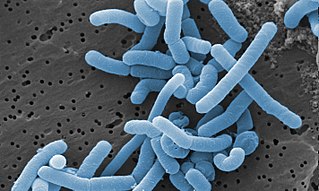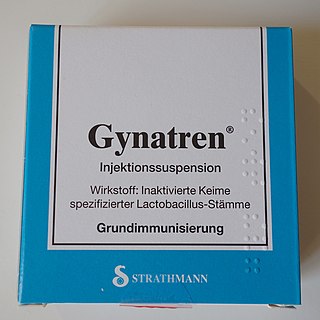
Lactobacillus is a genus of Gram-positive, aerotolerant anaerobes or microaerophilic, rod-shaped, non-spore-forming bacteria. Until March 2020, the genus Lactobacillus comprised over 260 phylogenetically, ecologically, and metabolically diverse species; a taxonomic revision of the genus in 2020 assigned lactobacilli to 25 genera.
Vaginitis, also known as vulvovaginitis, is inflammation of the vagina and vulva. Symptoms may include itching, burning, pain, discharge, and a bad smell. Certain types of vaginitis may result in complications during pregnancy.

Probiotics are live microorganisms promoted with claims that they provide health benefits when consumed, generally by improving or restoring the gut flora. Probiotics are considered generally safe to consume, but may cause bacteria-host interactions and unwanted side effects in rare cases. There is little evidence that probiotics bring the health benefits claimed for them.

Lactobacillus acidophilus is a species of Gram-positive bacteria in the genus Lactobacillus. L. acidophilus is a homofermentative, microaerophilic species, fermenting sugars into lactic acid, and grows readily at rather low pH values and has an optimum growth temperature of around 37 °C (99 °F). L. acidophilus is found in the human and animal gastrointestinal tract and mouth. Some strains of L. acidophilus may be considered to have probiotic characteristics. These strains are commercially used in many dairy products, sometimes together with Streptococcus thermophilus and Lactobacillus delbrueckii subsp. bulgaricus in the production of acidophilus-type yogurt, or acidophiline. Its genome has been sequenced.

Bacillus coagulans is a lactic acid–forming bacterial species first isolated and described in 1915 by B.W. Hammer at the Iowa Agricultural Experiment Station as a cause of an outbreak of coagulation in evaporated milk packed by an Iowa condensary. Separately isolated in 1935 and described as Lactobacillus sporogenes in the fifth edition of Bergey's Manual of Systematic Bacteriology, it exhibits characteristics typical of both genera Lactobacillus and Bacillus; its taxonomic position between the families Lactobacillaceae and Bacillaceae was often debated. However, in the seventh edition of Bergey's, it was finally transferred to the genus Bacillus. DNA-based technology was used in distinguishing between the two genera of bacteria, which are morphologically similar and possess similar physiological and biochemical characteristics.

Lacticaseibacillus rhamnosus is a bacterium that originally was considered to be a subspecies of L. casei, but genetic research found it to be a separate species in the L. casei clade, which also includes L. paracasei and L. zeae. It is a short Gram-positive homofermentative facultative anaerobic non-spore-forming rod that often appears in chains. Some strains of L. rhamnosus bacteria are being used as probiotics, and are particularly useful in treating infections of the female urogenital tract, most particularly very difficult to treat cases of bacterial vaginosis. The species Lacticaseibacillus rhamnosus and Limosilactobacillus reuteri are commonly found in the healthy female genito-urinary tract and are helpful to regain control of dysbiotic bacterial overgrowth during an active infection. L. rhamnosus sometimes is used in dairy products such as fermented milk and as non-starter-lactic acid bacterium (NSLAB) in long-ripened cheese. While frequently considered a beneficial organism, L. rhamnosus may not be as beneficial to certain subsets of the population; in rare circumstances, especially those primarily involving weakened immune system or infants, it may cause endocarditis. Despite the rare infections caused by L. rhamnosus, the species is included in the list of bacterial species with qualified presumed safety (QPS) status of the European Food Safety Agency.

Lactobacillales are an order of gram-positive, low-GC, acid-tolerant, generally nonsporulating, nonrespiring, either rod-shaped (bacilli) or spherical (cocci) bacteria that share common metabolic and physiological characteristics. These bacteria, usually found in decomposing plants and milk products, produce lactic acid as the major metabolic end product of carbohydrate fermentation, giving them the common name lactic acid bacteria (LAB).
Limosilactobacillus reuteri is a lactic acid bacterium found in a variety of natural environments, including the gastrointestinal tract of humans and other animals. It does not appear to be pathogenic and may have health effects.

Walter Dobrogosz is a Professor Emeritus of North Carolina State University, best known for his discovery and further research on the probiotic bacterium Lactobacillus reuteri.

The Lactobacillaceae are a family of lactic acid bacteria. It is the only family in the lactic acid bacteria which includes homofermentative and heterofermentative organisms; in the Lactobacillaceae, the pathway used for hexose fermentation is a genus-specific trait. Lactobacillaceae include the homofermentative lactobacilli Lactobacillus, Holzapfelia, Amylolactobacillus, Bombilactobacillus, Companilactobacillus, Lapidilactobacillus, Agrilactobacillus, Schleiferilactobacillus, Loigolactobacillus, Lacticaseibacillus, Latilactobacillus, Dellaglioa, Liquorilactobacillus, Ligilactobacillus, and Lactiplantibacillus; the heterofermentative lactobacilli Furfurilactobacillus, Paucilactobacillus, Limosilactobacillus, Fructilactobacillus, Acetilactobacillus, Apilactobacillus, Levilactobacillus, Secundilactobacillus, and Lentilactobacillus, which were previously classified in the genus Lactobacillus; and the heterofermentative genera Convivina, Frucctobacillus, Leuconostoc, Oenococcus, and Weissella which were previously classified in the Leuconostocaceae.
Levilactobacillus brevis is a gram-positive, rod shaped species of lactic acid bacteria which is heterofermentative, creating CO2, lactic acid and acetic acid or ethanol during fermentation. L. brevis is the type species of the genus Levilactobacillus (previously L. brevis group), which comprises 24 species (http://www.lactobacillus.ualberta.ca/, http://www.lactobacillus.uantwerpen.be/). It can be found in many different environments, such as fermented foods, and as normal microbiota. L.brevis is found in food such as sauerkraut and pickles. It is also one of the most common causes of beer spoilage. Ingestion has been shown to improve human immune function, and it has been patented several times. Normal gut microbiota L.brevis is found in human intestines, vagina, and feces.

Vaginal flora, vaginal microbiota or vaginal microbiome are the microorganisms that colonize the vagina. They were discovered by the German gynecologist Albert Döderlein in 1892 and are part of the overall human flora. The amount and type of bacteria present have significant implications for a woman's overall health. The primary colonizing bacteria of a healthy individual are of the genus Lactobacillus, such as L. crispatus, and the lactic acid they produce is thought to protect against infection by pathogenic species.
Limosilactobacillus fermentum is a Gram-positive species in the heterofermentative genus Limosilactobacillus. It is associated with active dental caries lesions. It is also commonly found in fermenting animal and plant material including sourdough and cocoa fermentation. A few strains are considered probiotic or "friendly" bacteria in animals and at least one strain has been applied to treat urogenital infections in women. Some strains of lactobacilli formerly mistakenly classified as L. fermentum have since been reclassified as Limosilactobacillus reuteri. Commercialized strains of L. fermentum used as probiotics include PCC, ME-3 and CECT5716
Limosilactobacillus mucosae is a rod shaped species of lactic acid bacteria first isolated from pig intestines. It has mucus-binding activity. The species is an obligate anaerobe, catalase-negative, doesn't form spores and is non-motile. Its type strain is S32T, and has been found to be most closely related to Limosilactobacillus reuteri.

Lacticaseibacillus paracasei is a gram-positive, homofermentative species of lactic acid bacteria that are commonly used in dairy product fermentation and as probiotic cultures. Lc. paracasei is a bacterium that operates by commensalism. It is commonly found in many human habitats such as human intestinal tracts and mouths as well as sewages, silages, and previously mentioned dairy products. The name includes morphology, a rod-shaped bacterium with a width of 2.0 to 4.0μm and length of 0.8 to 1.0μm.
Limosilactobacillus pontis is a rod-shaped, Gram-positive facultatively anaerobic bacterium. Along with other Lactobacillus species, it is capable of converting sugars, such as lactose, into lactic acid. Limosilactobacillus pontis is classified under the phylum "Firmicutes", class Bacilli, and is a member of the family Lactobacillaceae and is found to be responsible for the fermentation of sourdough, along with many other Lactobacillus species. This microorganism produces lactic acid during the process of fermentation, which gives sourdough bread its characteristic sour taste.
Lactiplantibacillus fabifermentans is a member of the genus Lactiplantibacillus and a type of lactic acid bacteria (LAB), a group of Gram-positive bacteria that produce lactic acid as their major fermented end product and that are often involved in food fermentation. L. fabifermentans was proposed in 2009 as a new species, after the type strain LMG 24284T has been isolated from Ghanaian cocoa fermentation. Analysis of the 16S rRNA gene sequence demonstrated that this species is a member of the Lactobacillus plantarum species group but further analysis demonstrated that it is possible to differentiate it from the nearest neighbors by means of DNA-DNA hybridization experiments, pheS sequence analysis, whole-cell protein electrophoresis, fluorescent amplified fragment length polymorphism analysis and biochemical characterization.
Lacticaseibacillus manihotivorans is a starch-hydrolysing lactic acid bacterium first isolated during Cassava sour starch fermentation. It is Gram-positive, catalase-negative, non-spore-forming, non-motile rod-shaped and homofermentative, with type strain OND 32T.

Lactobacillus vaccines are used in the therapy and prophylaxis of non-specific bacterial vaginitis and trichomoniasis. The vaccines consist of specific inactivated strains of Lactobacilli, called "aberrant" strains in the relevant literature dating from the 1980s. These strains were isolated from the vaginal secretions of patients suffering from acute colpitis. The lactobacilli in question are polymorphic, often shortened or coccoid in shape and do not produce an acidic, anti-pathogenic vaginal environment. A colonization with aberrant lactobacilli has been associated with an increased susceptibility to vaginal infections and a high rate of relapse following antimicrobial treatment. Intramuscular administration of inactivated aberrant lactobacilli provokes a humoral immune response. The production of specific antibodies both in serum and in the vaginal secretion has been demonstrated. As a result of the immune stimulation, the abnormal lactobacilli are inhibited, the population of normal, rod-shaped lactobacilli can grow and exert its defense functions against pathogenic microorganisms.
Limosilactobacillus is a thermophilic and heterofermentative genus of lactic acid bacteria created in 2020 by splitting from Lactobacillus. The name is derived from the Latin limosus "slimy", referring to the property of most strains in the genus to produce exopolysaccharides from sucrose. The genus currently includes 31 species or subspecies, most of these were isolated from the intestinal tract of humans or animals. Limosilactobacillus reuteri has been used as a model organism to evaluate the host-adaptation of lactobacilli to the human and animal intestine and for the recruitment of intestinal lactobacilli for food fermentations.








